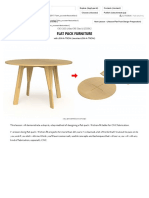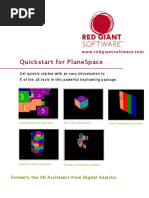How To Create Ivy
How To Create Ivy
Uploaded by
Mon AlejandroCopyright:
Available Formats
How To Create Ivy
How To Create Ivy
Uploaded by
Mon AlejandroOriginal Title
Copyright
Available Formats
Share this document
Did you find this document useful?
Is this content inappropriate?
Copyright:
Available Formats
How To Create Ivy
How To Create Ivy
Uploaded by
Mon AlejandroCopyright:
Available Formats
How to Create Ivy/ Crawler in Google SketchUp
Below is the tutorial of Zernan aka Zdesign sharing his workflow on his Ivy. Kudos to Zernan on his patience in modeling and sharing this.
Now I would like to cut the process and at the same time to introduce some scripts/plugins to automate and cut the modeling process. I will be using the following scripts in modeling: 1. Sandbox tool. This is included in the Google SketchUp. 2. Tools on Surface by Fredo which can be downloaded HERE. 3. Make Fur by Takahata which can be downloaded HERE. The idea behind this tutorial is more on how to automates Zernans approach and not really to do a super realistic ivy or creeper. I think the element of exploration will be left to you.
Step 1. Creating the general shape where the creeper will crawl. Here I used the sandbox tool of SketchUp and created a mesh. Then I used the Smoove tool to play the surface.
Step 2: Using the Tools on Surface script by Fredo. This script is a an excellent tool for terrain. Here, I drew the boundary of the crawler, creeper.
Step 3: Creating the Ivy/Creeper/Crawler based on Zernans tutorial
Step 4: Manipulating the component surface
Step 5. Applying the material I used Zernans jpeg material, but I converted it into png file and removed the white background (making the negative space as transparent).
Step 6. The Vray Material. Sketchup 1.48.66 up supports transparency of the material. TIFF or PNG files with transparency will not need a transparency map. All we need to do is to TICK use color texture for transparency.
Here is the test render in Vray SketchUp.
Step 7: Making the Ivy/creeper Component Be sure to make the face into a component to save file size.
Then copy, resize, and rotate the component. Vary the position and scale of the other copies. Save it again into a new component. I will call this bunch_ivy.
Step 8: The boundary of the Ivy. I erased the unwanted areas.
Step 9 - Using the fur maker script. I opened the Make Fur script and I choose CROWD (Web dialog).
Step 10: Selecting the area where the ivy will crawl. Select the boundary area. I ticked the ivy_bunch and entered in the dialogue box density 2000, jitter 10 and standup no.
Enter. The image below showed the components of the Ivy bunch crowded the selected area.
Here is the sample render in Vray SketchUp. Sorry if it does not look like an Ivy. I think with few more exploration, this can be further developed. I hope you find this useful. Nomeradona
You might also like
- Introduction To VRAY Sketchup - NomeradonaNo ratings yetIntroduction To VRAY Sketchup - Nomeradona62 pages
- Re-Creating Vintage Designs On T-Shirts: Michael PlochNo ratings yetRe-Creating Vintage Designs On T-Shirts: Michael Ploch12 pages
- Create The Glass Shelf Dock From Leopard OS in Photoshop - Tutorial9No ratings yetCreate The Glass Shelf Dock From Leopard OS in Photoshop - Tutorial912 pages
- SketchUp For Interior Design - Kirkwood Community CollegeNo ratings yetSketchUp For Interior Design - Kirkwood Community College118 pages
- Create A Vector Art Twitter Bird Character Icon: Adobe IllustratorNo ratings yetCreate A Vector Art Twitter Bird Character Icon: Adobe Illustrator27 pages
- Final Project Report - Yash Kolekar Bfa 20No ratings yetFinal Project Report - Yash Kolekar Bfa 2031 pages
- Modeling A Knight: You Created This PDF From An Application That Is Not Licensed To Print To Novapdf PrinterNo ratings yetModeling A Knight: You Created This PDF From An Application That Is Not Licensed To Print To Novapdf Printer17 pages
- Catch: Everyone at Wishes You All A Very and ANo ratings yetCatch: Everyone at Wishes You All A Very and A50 pages
- Architectural Rendering With SketchUp and Kerkythea - SketchUp 3D Rendering Tutorials by SketchUpArtistsNo ratings yetArchitectural Rendering With SketchUp and Kerkythea - SketchUp 3D Rendering Tutorials by SketchUpArtists13 pages
- Building A Model With ArcGIS ModelBuilder Saves TimeNo ratings yetBuilding A Model With ArcGIS ModelBuilder Saves Time10 pages
- Depthmap Software:: by Beatrix Emo: B.emo@gess - Ethz.chNo ratings yetDepthmap Software:: by Beatrix Emo: B.emo@gess - Ethz.ch10 pages
- Inkscape Tutorial - Seamless Patterns - VectorsNo ratings yetInkscape Tutorial - Seamless Patterns - Vectors17 pages
- Cambridge International AS & A Level Information Technology: Topic Support GuideNo ratings yetCambridge International AS & A Level Information Technology: Topic Support Guide9 pages
- Tutorial: Post-Production in 3ds Max and PhotoshopNo ratings yetTutorial: Post-Production in 3ds Max and Photoshop61 pages
- Basic Guide To Modeling Landscape Sins KetchupNo ratings yetBasic Guide To Modeling Landscape Sins Ketchup25 pages
- Making of Oak Pass House - 3D Architectural Visualization Rendering Blog PDFNo ratings yetMaking of Oak Pass House - 3D Architectural Visualization Rendering Blog PDF23 pages
- Animation With Krita - Krita Manual Version 4.1100% (1)Animation With Krita - Krita Manual Version 4.120 pages
- Pipe Components Manual VER. 1.0: Junar B. AmaroNo ratings yetPipe Components Manual VER. 1.0: Junar B. Amaro11 pages
- Cool Text Effect With The Puppet Warp Tool in Photoshop CS5 - AbduzeedoNo ratings yetCool Text Effect With The Puppet Warp Tool in Photoshop CS5 - Abduzeedo13 pages
- Re-Creating Vintage Designs On T-Shirts: Michael PlochRe-Creating Vintage Designs On T-Shirts: Michael Ploch
- Create The Glass Shelf Dock From Leopard OS in Photoshop - Tutorial9Create The Glass Shelf Dock From Leopard OS in Photoshop - Tutorial9
- SketchUp For Interior Design - Kirkwood Community CollegeSketchUp For Interior Design - Kirkwood Community College
- Create A Vector Art Twitter Bird Character Icon: Adobe IllustratorCreate A Vector Art Twitter Bird Character Icon: Adobe Illustrator
- Modeling A Knight: You Created This PDF From An Application That Is Not Licensed To Print To Novapdf PrinterModeling A Knight: You Created This PDF From An Application That Is Not Licensed To Print To Novapdf Printer
- Architectural Rendering With SketchUp and Kerkythea - SketchUp 3D Rendering Tutorials by SketchUpArtistsArchitectural Rendering With SketchUp and Kerkythea - SketchUp 3D Rendering Tutorials by SketchUpArtists
- Building A Model With ArcGIS ModelBuilder Saves TimeBuilding A Model With ArcGIS ModelBuilder Saves Time
- Depthmap Software:: by Beatrix Emo: B.emo@gess - Ethz.chDepthmap Software:: by Beatrix Emo: B.emo@gess - Ethz.ch
- Cambridge International AS & A Level Information Technology: Topic Support GuideCambridge International AS & A Level Information Technology: Topic Support Guide
- Tutorial: Post-Production in 3ds Max and PhotoshopTutorial: Post-Production in 3ds Max and Photoshop
- Making of Oak Pass House - 3D Architectural Visualization Rendering Blog PDFMaking of Oak Pass House - 3D Architectural Visualization Rendering Blog PDF
- Cool Text Effect With The Puppet Warp Tool in Photoshop CS5 - AbduzeedoCool Text Effect With The Puppet Warp Tool in Photoshop CS5 - Abduzeedo



























































